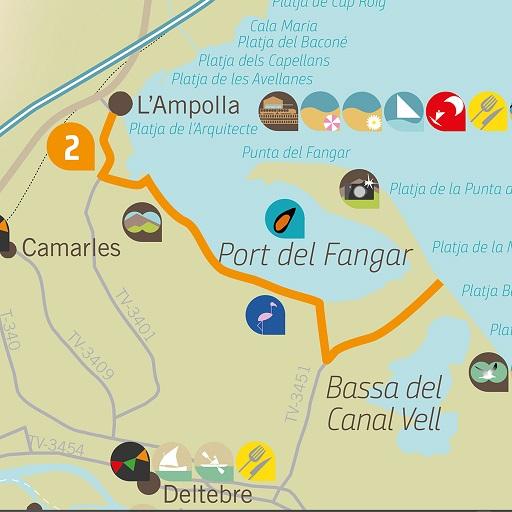Route 2. Fangar Bay
Departure point: L'Ampolla
Duration: full day
Route by car: 14,6 km
Walking route: 200 m
Circular: no
We begin this route in the port of the coastal town of L'Ampolla. In the slipstream of the wind there are several species of gulls, such as the black-headed gull and Audouin's gull resting on the docks and boats. Continue driving along the shore to the entrance of Fangar Bay, visible from higher points, where you can already detect some species of marine birds typical of these areas such as the great crested grebe, the black-necked grebe and throughout the winter months, sea ducks such as the common scoter the surf scoter or the great loon. Once you have bordered the bay and the beach of L'Ampolla, take the TV-3401 towards Deltebre, then after a few kilometres there is a turn off to the left leading to Bassa de les Olles (Olles lagoon). Here you can see different species of ducks as well as seagulls and terns who momentarily leave the salt water to rest and drink in the lagoon. But perhaps the most interesting thing is the reeds surrounding it, where from March we constantly hear the song of Savi's warbler, surrounded by a huge number of great reed warblers and common reed warblers hurrying to conquer territory and mate.
Then, drive along a dirt track to the Gola de Les Olles, a canal leading into the sea, where a whole range of gulls and terns can often be seen at a short distance. We enter the bay from its northern part. From here we follow the dirt track that borders the shallow water of Fangar Bay on the one side, and on the other, the green filter reedbeds (areas flooded with reedbeds that help improve water quality),where it is worth making a stop to look for birds such as the little bittern, the purple swamphen and track the groups of ducks to spot the mallard and marbled teal, rarities in the delta but this is one of their favourite places. During migration periods, thousands of wading birds gather here to gain energy from the invertebrates they find in the mud. With good binoculars you can see oystercatchers all year round at the tip of the last sandbar. Hundreds of flamingos add colour to the area.
Stopping off at the Illa de Mar harbour is a must as it is used exclusively for shellfish farming, so among the remains after the oysters and mussels have been collected, it is easy to observe ruddy turnstones. Most of the medium-sized red-breasted mergansers wintering in this area are found further away, often diving among the mussel beds. Follow the track south which eventually turns inland, at which point we cross some of the best rice fields in the delta for birdwatching, especially during the winter period, when large numbers of plovers, dunlins, sandpipers or godwits keep us well entertained. Once you reach the paved track that leads directly to La Marquesa beach, head towards the sea, stopping constantly to look at the rice fields in search of interesting species like Temminck's sandpiper, little ringed plover or often large flocks of black-tailed godwits.
Arriving at the Els Vascos restaurant, we find fields with muddy channels where it is normal to see spotted crakes during the months of March and April, as well as the continuous comings and goings of bluethroats. On reaching the sea, stop for some sea-watching to observe Mediterranean and Balearic shearwaters or groups of sanderlings and Kentish plovers following the rhythm of the waves.
Phenology:
Undoubtedly the migratory passage, in spring (March-May) and autumn (August-October), is when the greatest diversity of species can be seen, completing observer`s bird checklists with a large number of species. However, we must not forget the summer period, when nesting colonies are formed, or the winter, when a good number of aquatic birds find refuge in the calm waters of the bay. In other words, this area can be visited at any time, giving lots of satisfaction for bird watchers.
Track GPX
We also make the route file available to you in gpx format so that you can use it with your GPS device (see link in the header).






